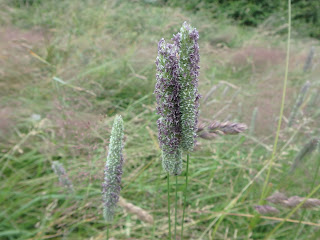I forced myself out of the house, after work on Monday, for a quick yomp through the Stratford Reserve. It was a muggy, overcast evening, but the dull light seemed to intensify the colours of the vegetation.
In particular, I was struck by the variety of colours and forms of the grasses that had been left to grow especially long. Timothy grass - purplish 'cats' tails' of flower heads, drooping yellowish false oat grass, mingling with the stiff, dark green heads of rye grass.
The walk also runs along some arable fields, and it is clear that the farmer is in an environmental stewardship scheme, as their field corner has been left unsown - it's alive with insects including marbled white butterflies, and has a great variety of grasses itself, as well as wildflowers such as common knapweed.
I'm no expert on grasses and as an ecologist I struggle to retain the knowledge on identifying species, but this year I feel I've discovered how beautiful they can be, which has really helped in remembering certain species. Of course, it's difficult unless you're regularly outside surveying, which I am not these days, sadly.
However, saying that, I did manage to persuade some of my team to take me out on a day of site visits connected to protected species licensing for works. The first site was on an MoD rifle range with stunning views out across the Fleet to Chesil beach. Both are SSSIs, due in part to the unusual formation of Chesil beach - a stretch of shingle connecting the mainland with the Isle of Portland. Tt encloses the largest saline lagoon in Britain ('the Fleet'). Both are also internationally important for the breeding and overwintering birds they support, notably breeding little terns. For me, this pat of the world brings back childhood memories. my Granny lived in Upwey just down the road, and we would often pop to the Abbotsbury swannery on the shores of the Fleet.
This weekend the Wimbledon finals will likely prevent any outdoor excursions!




No comments:
Post a Comment